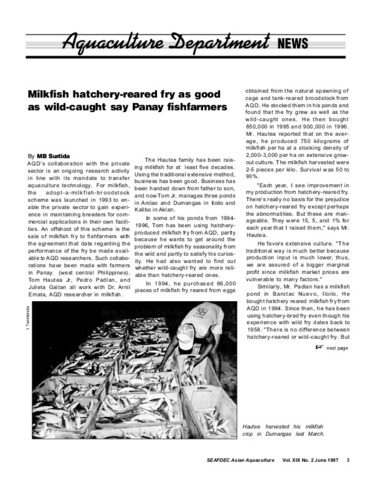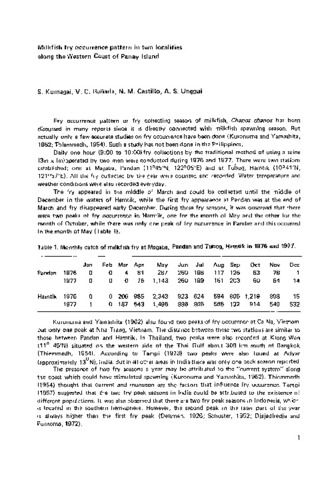Broodstock transplantation: An approach for stock enhancement of the 'kapis' shell Placuna placenta along Panay Gulf, central Philippines
| dc.contributor.author | Madrones-Ladja, Jocelyn A. | |
| dc.contributor.author | Aldon, Eva T. | |
| dc.contributor.author | Baliao, Dan D. | |
| dc.date.accessioned | 2014-09-04T06:51:55Z | |
| dc.date.available | 2014-09-04T06:51:55Z | |
| dc.date.issued | 2012 | |
| dc.identifier.citation | Madrones-Ladja, J. A., Aldon, E. T., & Baliao, D. D. (2012). Broodstock transplantation: An approach for stock enhancement of the 'kapis' shell Placuna placenta along Panay Gulf, central Philippines. The Philippine Agricultural Scientist, 95(2), 192-198. | en |
| dc.identifier.issn | 0031-7454 | |
| dc.identifier.uri | http://hdl.handle.net/10862/2127 | |
| dc.description.abstract | The Panay Gulf in central Philippines once supported a substantial ‘kapis’ Placuna placenta (Linnaeus) population that was among the six major sources for this species. However, stock depletion began in the late 1980s because of overexploitation and destructive fishing practices. To recover the declining ‘kapis’ fishery along the Gulf, a broodstock transplantation program was initiated in 1999. Results from a survey of the Gulf prior to this program confirmed reports of resource depletion. Four (4) transplantation sites (S) with natural soft-muddy substrata in adjacent coastal towns, namely, Tigbauan (S1 and S2), Guimbal (S3) and Oton (S4) were established and stocked with 3200 (1:1 male to female ratio) sexually mature ‘kapis’ broodstock collected from nearby Negros Island in March–October 1999. Transplant survival along the sites ranged 80–100%. Spontaneous spawning by ‘kapis’ transplants occurred from March 1999 (15 d after first stocking) through May 2000. Larvae (5 larvae per L) began to appear at S1 15 d after transplantation and progressively increased in density to 23 larvae per L in November 1999. During this period, local divers reported big patches of ‘kapis’ juveniles [shell length (SL), 38 ± 11 mm] at S4. Sex ratio of recruits was 3:2 (male: female). Larvae became abundant off the nearby coasts with a strong recruitment pulse at 160 larvae per L at S4 by January 2000. Likewise, transplants taken to the laboratory were induced to spawn by photochemical method, and thus validated the spawning that occurred in transplantation sites. Juvenile recruits were of variable sizes, indicating that spawning was not simultaneous. Sexually mature juvenile recruits (40% female, 90% male) were already observed in January–February 2000. The recruitment apparently resulting from these transplants was local, dispersion ranging from zero to a few kilometers distance from transplantation sites. ‘Kapis’ harvest began in 2007 for local market consumption while commercial harvest was done in 2010 with approximately 600 tons. The repopulation of ‘kapis’ along Panay Gulf after a decade indicated the success of the restocking program which was attributed to the suitability of the species, reproduction of transplants and the proper management of the newly established resource by the coastal fishers who are members of a local organization (FARMC) with the support of local government units (LGUs). | en |
| dc.language.iso | en | en |
| dc.publisher | College of Agriculture, University of the Philippines Los Baños | en |
| dc.subject | Placuna placenta | en |
| dc.subject | Philippines, Panay I., Panay Gulf | en |
| dc.title | Broodstock transplantation: An approach for stock enhancement of the 'kapis' shell Placuna placenta along Panay Gulf, central Philippines | en |
| dc.type | Article | en |
| dc.citation.volume | 95 | |
| dc.citation.issue | 2 | |
| dc.citation.spage | 192 | |
| dc.citation.epage | 198 | |
| dc.citation.journalTitle | The Philippine Agricultural Scientist | en |
| seafdecaqd.databank.controlnumber | 2012- | |
| dc.subject.asfa | breeding stock | en |
| dc.subject.asfa | fishery management | en |
| dc.subject.asfa | induced ovulation | en |
| dc.subject.asfa | marine molluscs | en |
| dc.subject.asfa | molluscan larvae | en |
| dc.subject.asfa | stocking (organisms) | en |
| dc.subject.asfa | stocks | en |
| dc.subject.asfa | transplantation | en |
| dc.subject.asfa | wild spawning | en |
Files in this item
| Files | ขนาด | รูป | View |
|---|---|---|---|
|
There are no files associated with this item. |
|||
รายการนี้ปรากฏใน (s)
-
Journal Articles [1256]
These papers were contributed by Department staff to various national and international journals.



